Analysis of the Mechanical Properties and Damage Mechanism of Carbon Fiber/Epoxy Composites under UV Aging
Abstract
:1. Introduction
2. Experiment
2.1. Materials
2.2. CFRP Composite Preparation
2.3. Ultraviolet Aging Test
2.4. Macroscopic Mechanical Test
2.4.1. Unidirectional Tensile and Compression Tests
2.4.2. Flexural and Short Beam Shear Test
2.4.3. V-Notched Rail Shear Test
2.5. Micromechanical Test
2.5.1. SEM and Weightlessness Analysis
2.5.2. FTIR Analysis
2.5.3. DMA Analysis
2.5.4. Nanoindentation Test
3. Results and Discussion
3.1. Weightlessness and Surface Morphology Analysis
3.2. Fourier Transform Infrared Spectroscopy (FTIR) Analysis
3.3. Dynamic Thermomechanical Analysis (DMA)
3.4. Tensile Tests Results and Discussion
3.5. Compression Tests Results and Discussion
3.6. Flexural Tests and Interlaminar Shear Tests Results and Discussion
3.7. V-Notched Rail Shear Test Results and Discussion
3.8. Nanoindentation Test Results and Discussion
4. Further Discussion
5. Conclusions
- (1)
- The UV aging had a deteriorating effect on multiple mechanical properties, with the most significant effect on the mechanical properties in the longitudinal direction, where the strength/modulus decreased with increasing UV exposure time. The longitudinal compression strength decreased the most by 23% due to the deterioration of the mechanical properties of the fiber/matrix interface caused by UV aging. The mechanical properties in the non-principal direction (transverse tensile, V-notched shear) increased in the early stage of UV aging, which was due to the post-curing effect, and caused the molecular chains to cross-link. A decreasing trend was also observed in the late aging period. This was due to the weaker post-curing effect than the degradation effect of UV irradiation in the latter stages of UV aging;
- (2)
- According to FTIR analysis, the epoxy resin matrix was degraded under UV exposure, and the chemical bonds or molecular forces in the chain segments were broken, resulting in free reactive radicals, which reacted with oxygen in the air to form small molecules, such as peroxides, causing some of the epoxy resin to peel off and form fragments and holes. The SEM showed that some of the gaps between the fibers and the matrix increased and the bonding became worse. This was the reason why the mechanical properties of the CFRP were reduced;
- (3)
- The nanoindentation results showed that the hardness of fibers was less affected by UV irradiation, while the hardness and modulus of the matrix were more affected by UV irradiation, which had a brittle effect on the matrix material. The overall hardness and modulus tended to increase. The high hardness fibers will play a strengthening role on the surrounding low hardness resin. In the early aging period, the UV embrittlement effect of the resin at the interface was the dominant effect, leading to the increase in its hardness, and in the late aging period, the near-fiber effect declined, leading to the premature decrease in its hardness. The interface region and the matrix have a similar law in terms of modulus;
- (4)
- Through the remaining strength model, it can be concluded that after 800 days of aging, the compression remaining strength retention rate was only 51%, and it was more sensitive to the UV aging effect, which is the key point to pay attention to in the service process of CFRP materials.
Author Contributions
Funding
Institutional Review Board Statement
Informed Consent Statement
Data Availability Statement
Acknowledgments
Conflicts of Interest
References
- Sethi, S. Environmental Degradation Study of FRP Composites Through Evaluation of Mechanical Properties. Ph.D. Thesis, Department of Metallurgical and Materials Engineering, National Institute of Technology, Rourkela, India, May 2014. [Google Scholar]
- Batista, N.L.; de Faria, M.C.M.; Iha, K.; de Oliveira, P.C.; Botelho, E.C. Influence of water immersion and ultraviolet weathering on mechanical and viscoelastic properties of polyphenylene sulfide–carbon fiber composites. J. Thermoplast. Compos. Mater. 2013, 28, 340–356. [Google Scholar] [CrossRef]
- Gardette, J.L. Polymer Degradation and Stability. Polym. Sci. 2006, 87, 171–181. [Google Scholar]
- Singh, B.; Sharma, N. Mechanistic implications of plastic degradation. Stability 2008, 93, 561–584. [Google Scholar] [CrossRef]
- Shin, P.S.; Kim, J.H.; Park, H.S.; Baek, Y.M.; Park, J.M. A Review: Mechanical and Interfacial Properties of Composites after Diverse Types of Aging Using Micromechanical Evaluation. Fibers Polym. 2020, 21, 225–237. [Google Scholar] [CrossRef]
- Larche, J.F.; Bussiere, P.O.; Therias, S.; Gardette, J.L. Photooxidation of polymers: Relating material properties to chemical changes. Polym. Degrad. Stab. 2012, 97, 25–34. [Google Scholar] [CrossRef]
- Cysne Barbosa, A.P.; Fulco, A.P.P.; Guerra, E.S.S.; Arakaki, F.K.; Tosatto, M.; Costa, M.C.B.; Melo, J.D.D. Accelerated aging effects on carbon fiber/epoxy composites. Compos. Part B Eng. 2016, 110, 298–306. [Google Scholar] [CrossRef]
- Zavatta, N.; Rondina, F.; Falaschetti, M.P.; Donati, L. Effect of Thermal Ageing on the Mechanical Strength of Carbon Fibre Reinforced Epoxy Composites. Polymers 2021, 13, 2006. [Google Scholar] [CrossRef]
- Ding, J.; Cheng, L. Experimental study on ultrasonic three-point bending fatigue of CFRP under ultraviolet radiation. Eng. Fract. Mech. 2020, 242, 107435. [Google Scholar] [CrossRef]
- Marouani, S.; Curtil, L.; Hamelin, P. Ageing of carbon/epoxy and carbon/vinylester composites used in the reinforcement and/or the repair of civil engineering structures. Compos. Part B 2012, 43, 2020–2030. [Google Scholar] [CrossRef]
- Goel, A.; Chawla, K.K.; Vaidya, U.K.; Koopman, M.; Dean, D.R. Effect of UV exposure on the microstructure and mechanical properties of long fiber thermoplastic (LFT) composites. J. Mater. Sci. 2008, 43, 4423–4432. [Google Scholar] [CrossRef]
- Cordelle, A.; Drissi-Habti, M. Nanoindentation Characterization of Vinylester Glass-fiber Composites Submitted to Dense Ultraviolet Radiation Exposure. Mater. Eval. 2014, 71, 466–473. [Google Scholar]
- Mp, B.; Os, A.; Mg, A. Gradients of cyclic indentation mechanical properties in PR520 epoxy and its 3D carbon fiber composite induced by aging at 150 °C. Polym. Degrad. Stab. 2021, 193, 109720. [Google Scholar]
- Babu, L.K.; Mishra, K.; Singh, R. Near–fiber effects of UV irradiation on the fiber–matrix interphase: A combined experimental and numerical investigation. Mater. Des. 2018, 157, 294–302. [Google Scholar] [CrossRef]
- Dever, J.A.; Messer, R.; Powers, C.; Townsend, J.; Wooldridge, E. Effects of Vacuum Ultraviolet Radiation on Thin Polyimide Films. High Perform. Polym. 2001, 13, S391–S399. [Google Scholar] [CrossRef]
- Astm, D. Standard Test Method for Tensile Properties of Polymer Matrix Composite Materials; ASTM International: West Conshohocken, PA, USA, 2008. [Google Scholar]
- Standard, A. Standard Test Method for Compressive Properties of Polymer Matrix Composite Materials Using a Combined Loading Compression (CLC) Test Fixture; ASTM International: West Conshohocken, PA, USA, 2009. [Google Scholar]
- Association, J.S. Fibre-Reinforced Plastic Composites: Determination of Apparent Interlaminar Shear Strength by Short-Beam Method; ISO: Geneva, Switzerland, 1997. [Google Scholar]
- ASTM D 7078; Standard Test Method for Shear Properties of Composite Materials by V-Notched Rail Shear Method. ASTM International: West Conshohocken, PA, USA, 2005.
- ISO 6721-1; Plastics—Determination of Dynamic Mechanical Properties. ISO: Geneva, Switzerland, 2001.
- Oliver, W.C.; Pharr, G.M. An improved technique for determining hardness and elastic modulus using load and displacement sensing indentation experiments. J. Mater. Res. 1992, 7, 1564–1583. [Google Scholar] [CrossRef]
- Oliver, W.C.; Pharr, G.M. Measurement of hardness and elastic modulus by instrumented indentation: Advances in understanding and refinements to methodology. J. Mater. Res. 2004, 19, 3–20. [Google Scholar] [CrossRef]
- Hardiman, M.; Vaughan, T.J.; Mccarthy, C.T. A review of key developments and pertinent issues in nanoindentation testing of fibre reinforced plastic microstructures. Compos. Struct. 2017, 180, 782–798. [Google Scholar] [CrossRef]
- Merino-Perez, J.L.; Royer, R.; Ayvar-Soberanis, S.; Merson, E.; Hodzic, A. On the temperatures developed in CFRP drilling using uncoated WC-Co tools Part I: Workpiece constituents, cutting speed and heat dissipation. Compos. Struct. 2015, 123, 161–168. [Google Scholar] [CrossRef] [Green Version]
- Zhang, Q.; Huang, G. Research on the Effect of UV Radiation on Glass Fiber Reinforced Composites. J. Hunan Univ. Sci. Technol. 2010, 24, 35–38. [Google Scholar]
- Bardi, M.G.A.; Munhoz, M.L.; Oliveira, H.; Auras, R.; Machado, L.D.B. Behavior of UV-cured print inks on LDPE and PBAT/TPS blend substrates during curing, postcuring, and accelerated degradation. J. Appl. Polym. Sci. 2015, 131, 547–557. [Google Scholar]
- Huang, Y.J.; Lin, Y.E.; Liao, X.; Huang, G.S.; Dan, Y.; Guo, S.Y.; Tao, Y.J.; Jie, G.X.; Li, G.-X. The Degradation Behavior, Service Lifetime Prediction and Stabilization Strategy of Polymeric Materials under Complex Condition. Chin. Polym. Bull. 2017, 10, 52–63. [Google Scholar]
- Xie, F.; Zhang, T.; Bryant, P.; Kurusingal, V.; Colwell, J.M.; Laycock, B. Degradation and stabilization of polyurethane elastomers. Prog. Polym. Sci. 2019, 90, 211–268. [Google Scholar] [CrossRef]
- Zhe, L.; Swa, B.; Song, Z.; Yfa, B.; Ypa, B.; Jga, B. Deformation response of gradient low-temperature gaseous carburized case in austenitic stainless steel during cyclic nanoindentation. Mater. Today Commun. 2021, 28, 102714. [Google Scholar]
- Fischer-Cripps, A.; Nicholson, D. Nanoindentation. Mechanical Engineering Series. Appl. Mech. Rev. 2004, 57, B12. [Google Scholar] [CrossRef]
- Choi, S.S.; Kim, J.-C. Lifetime prediction and thermal aging behaviors of SBR and NBR composites using crosslink density changes. J. Ind. Eng. Chem. 2012, 18, 1166–1170. [Google Scholar] [CrossRef]
- Wang, Y.; Lan, H.Q.; Meng, T. Lifetime prediction of natural gas polyethylene pipes with internal pressures. Eng. Fail. Anal. 2018, 95, 154–163. [Google Scholar] [CrossRef]
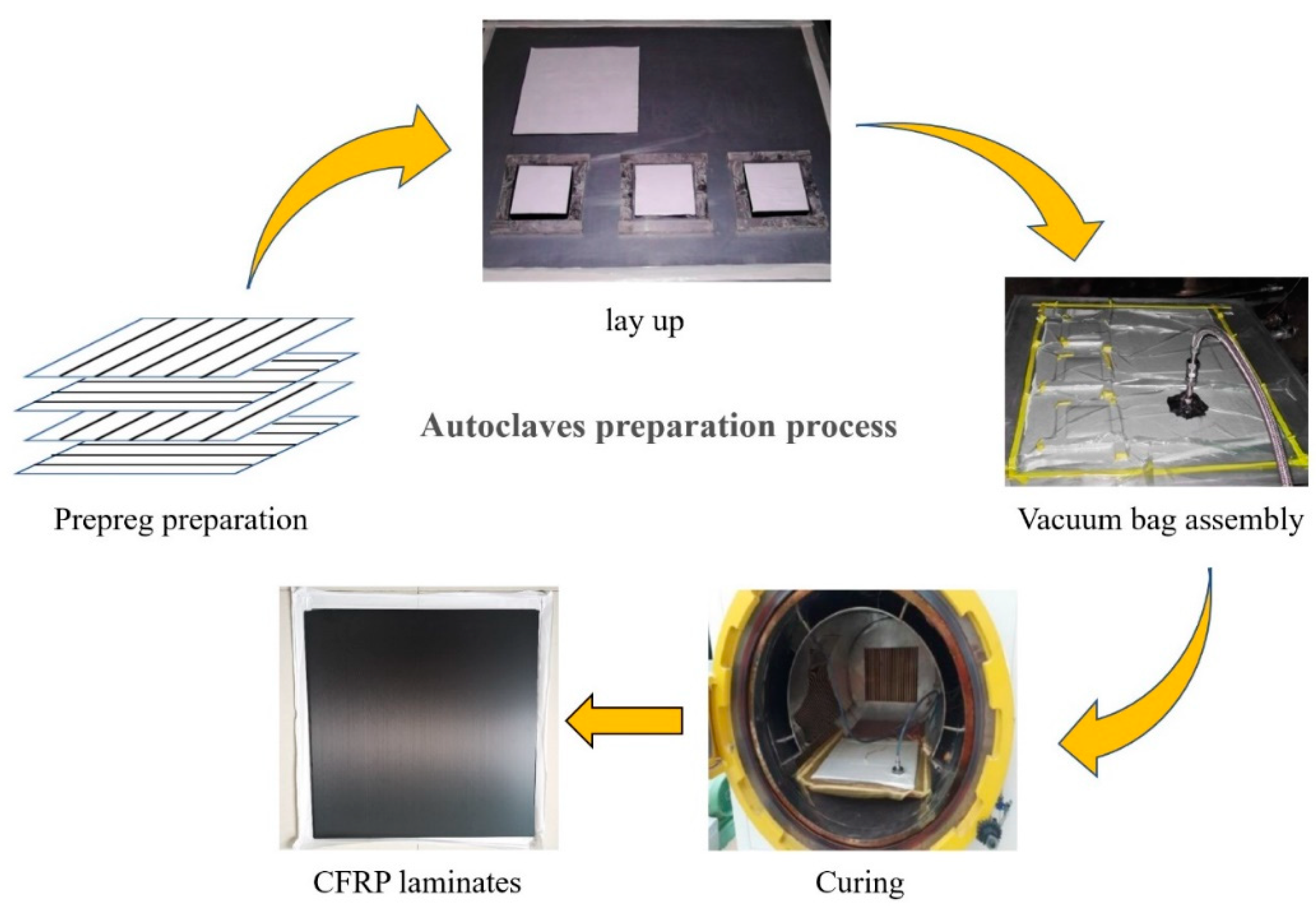
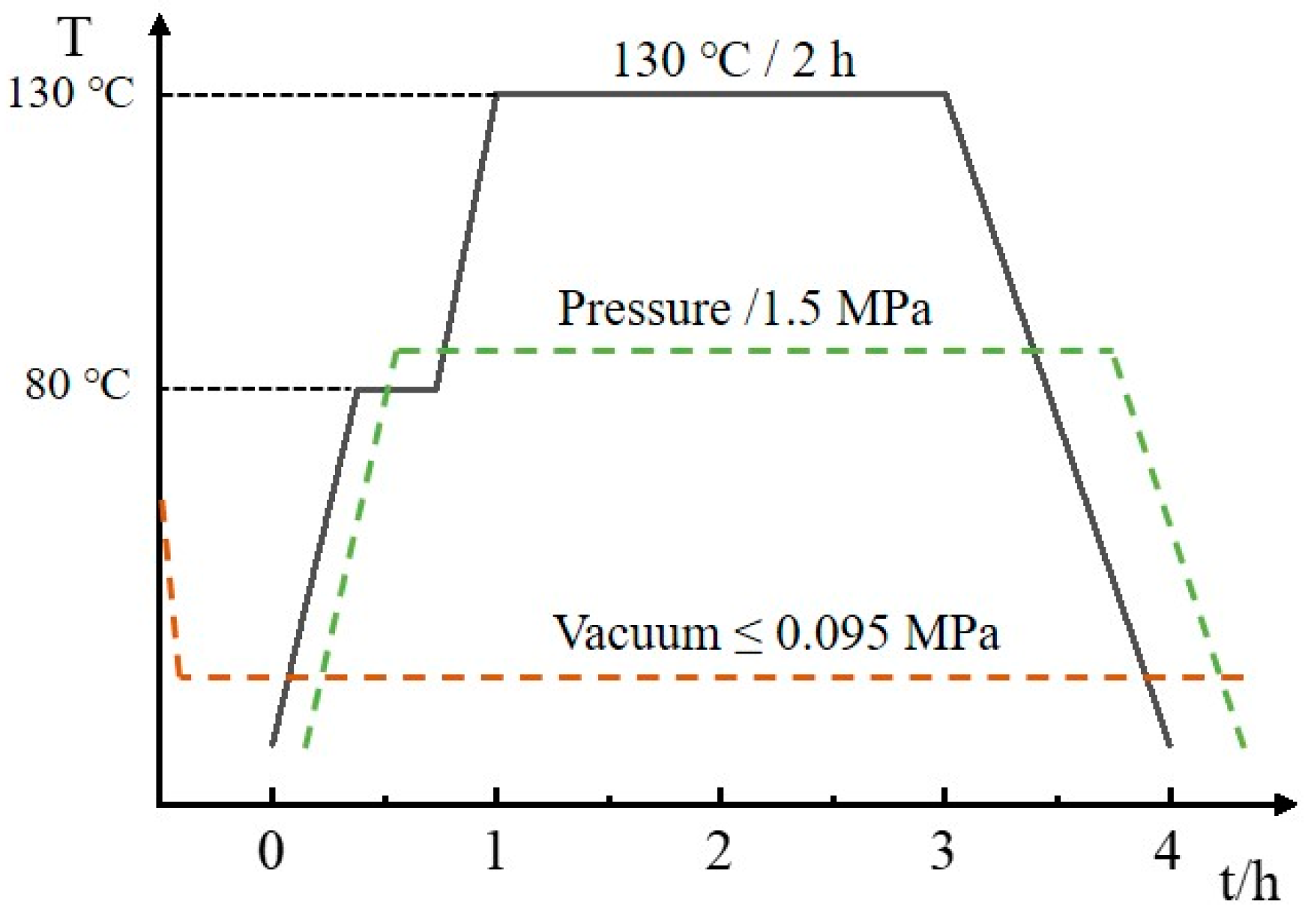
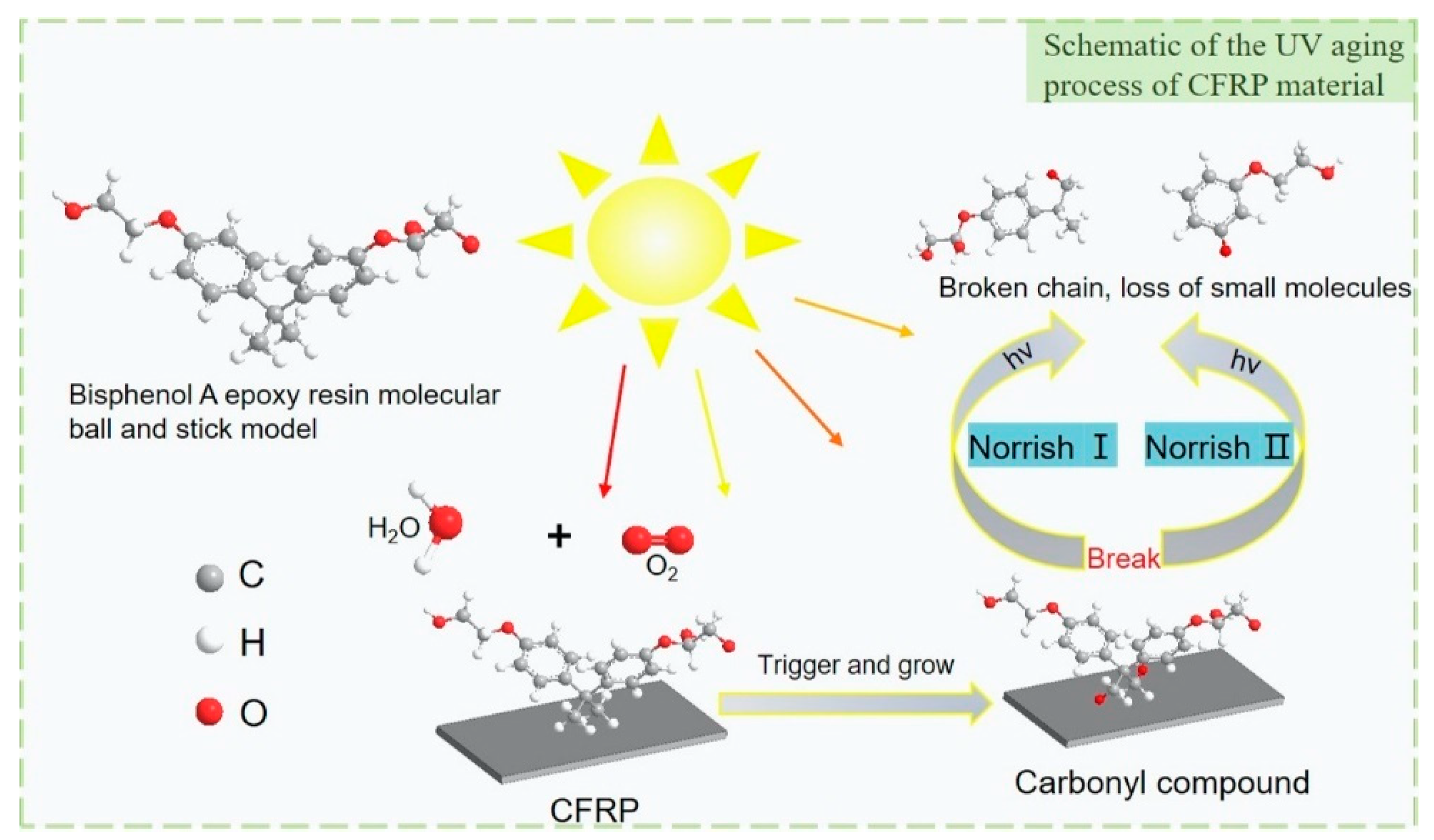

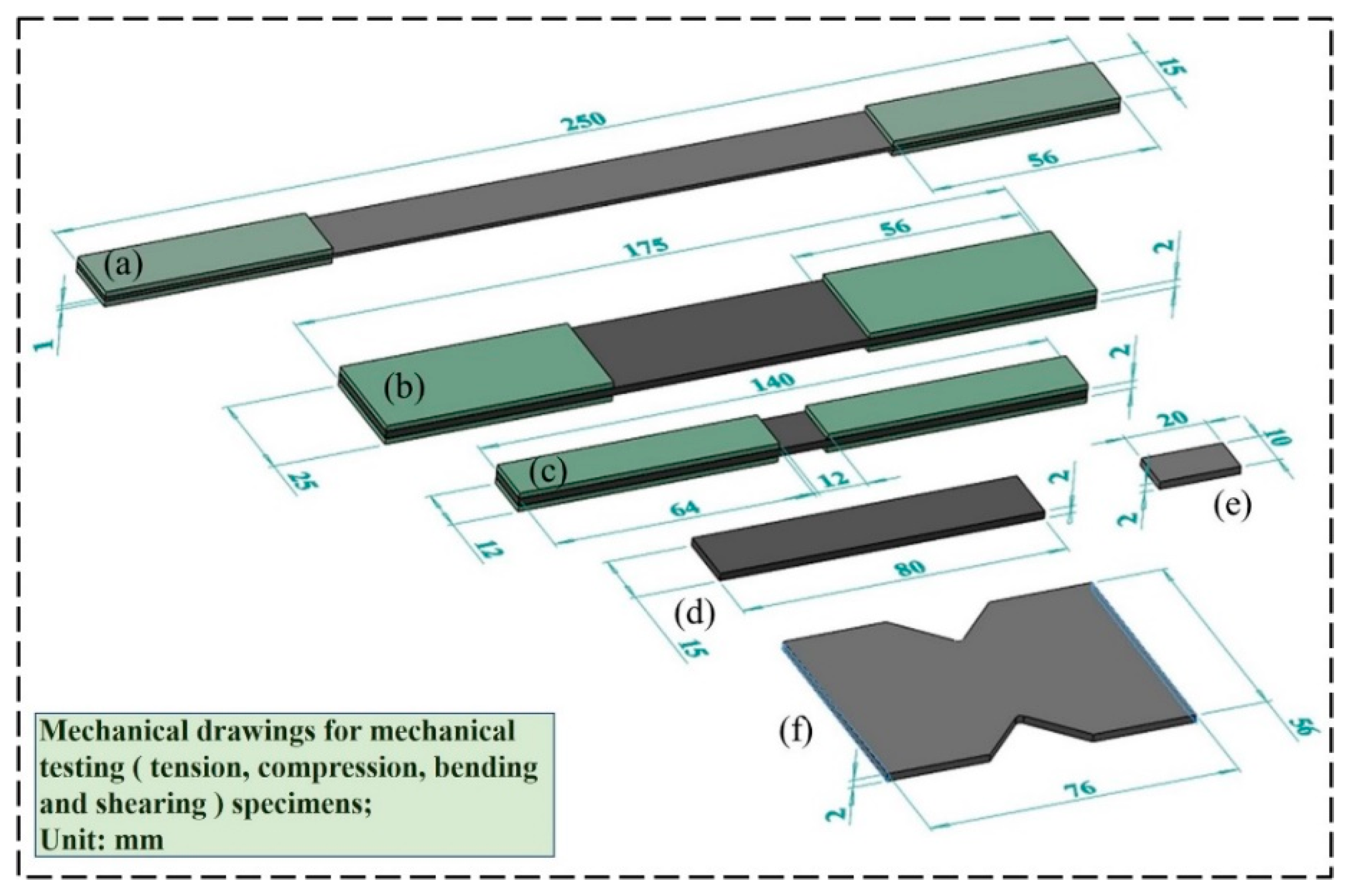
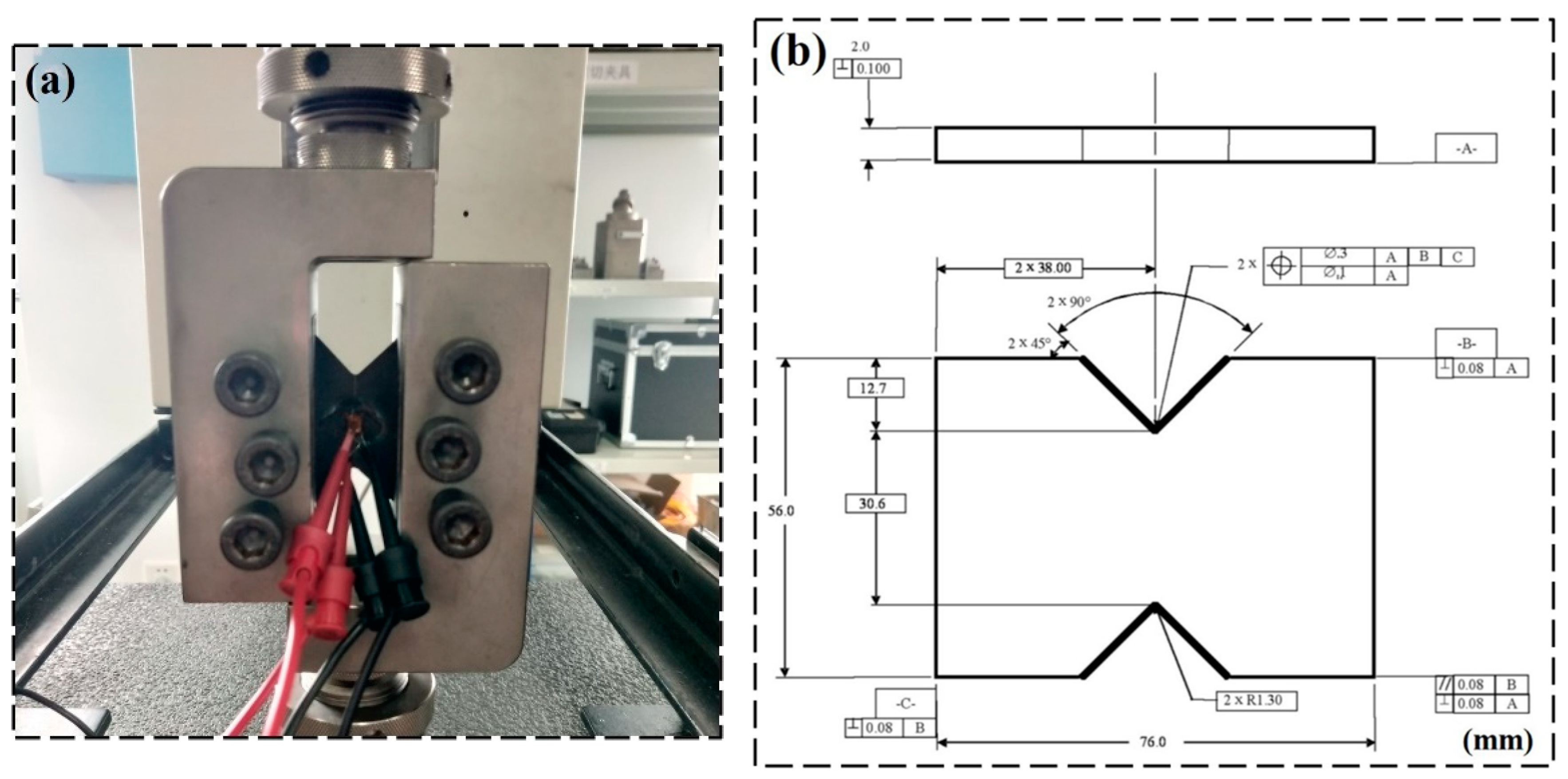

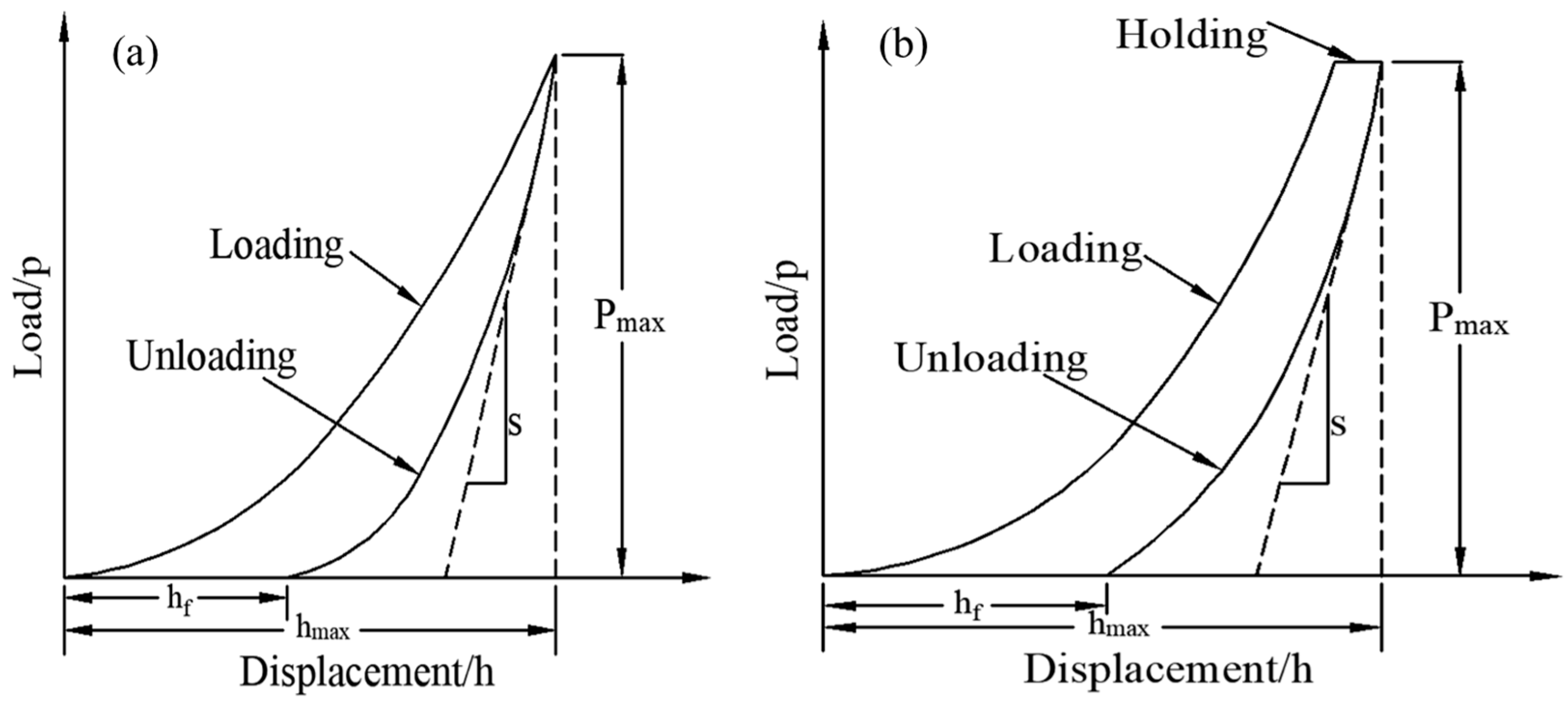
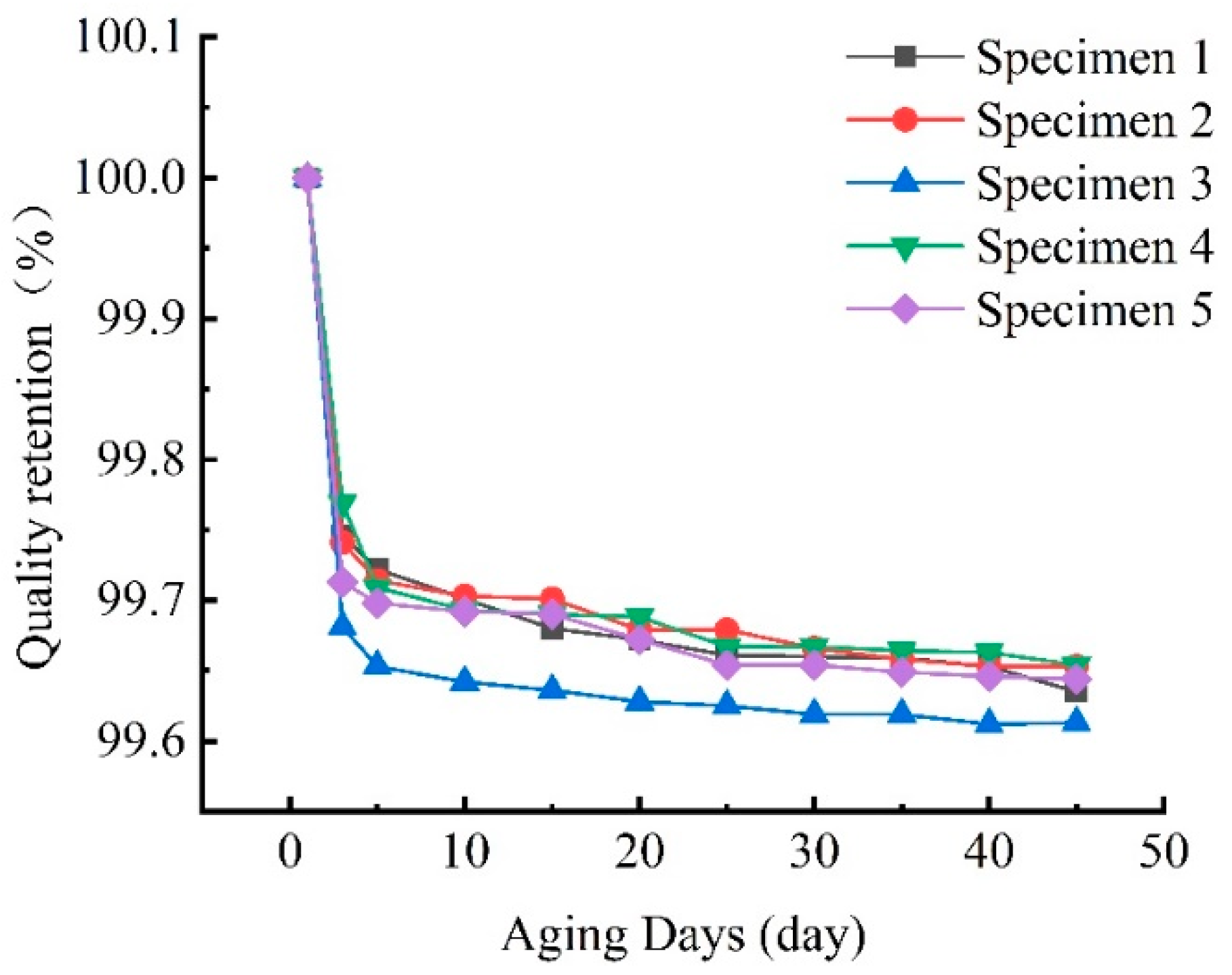
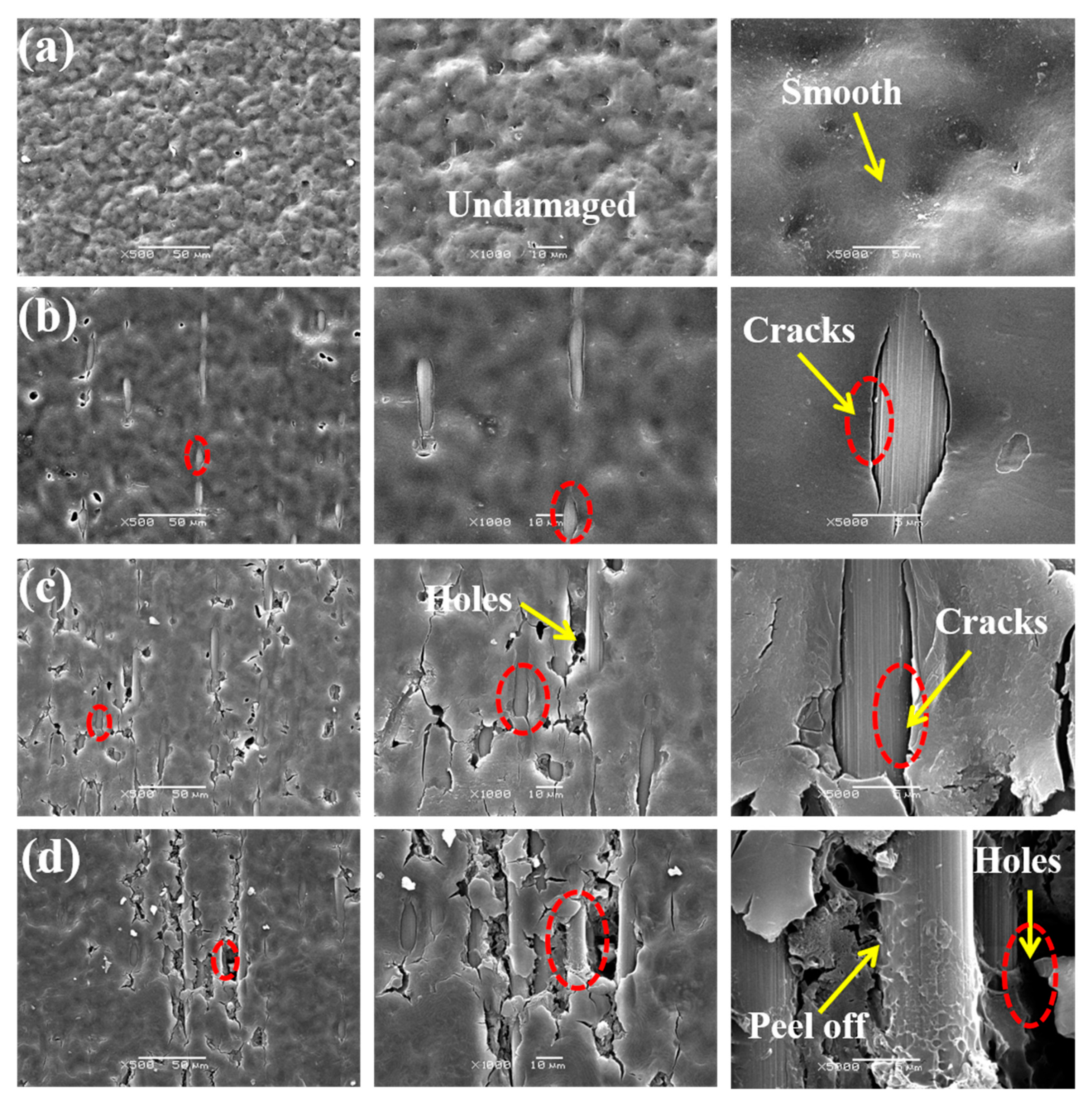
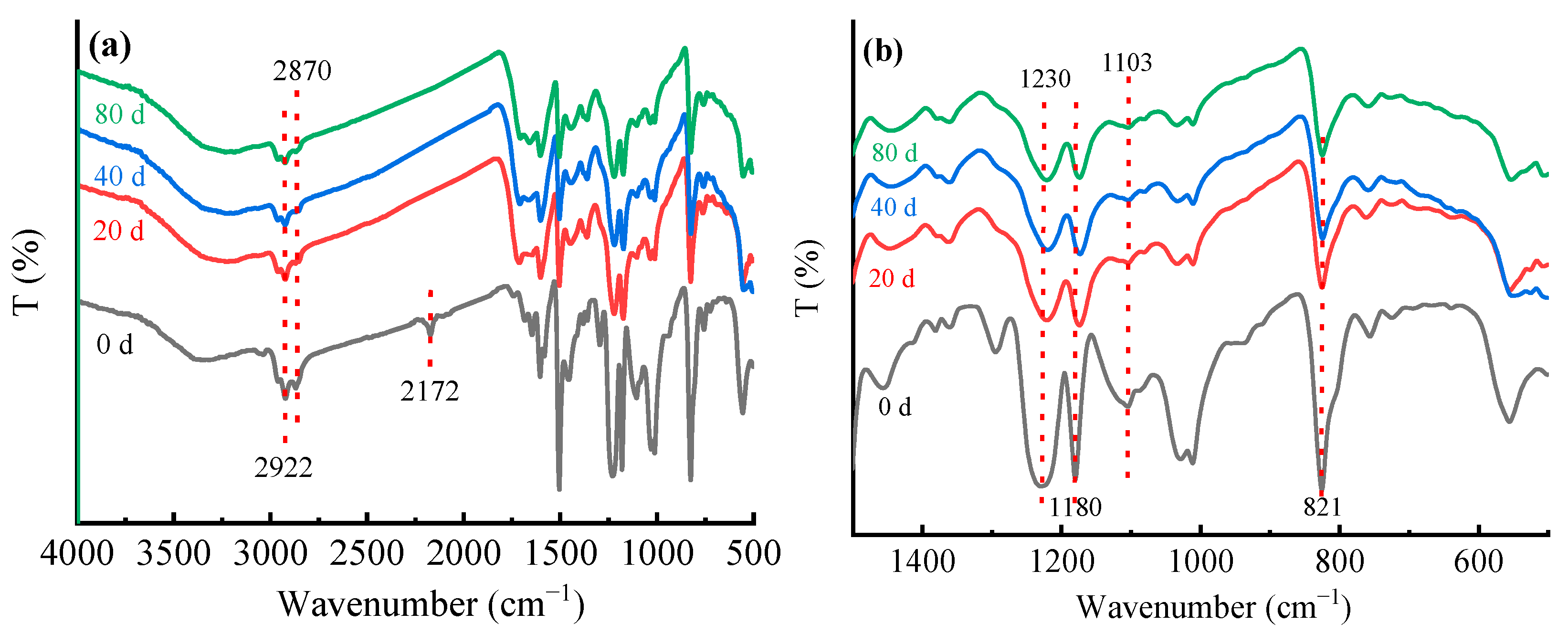

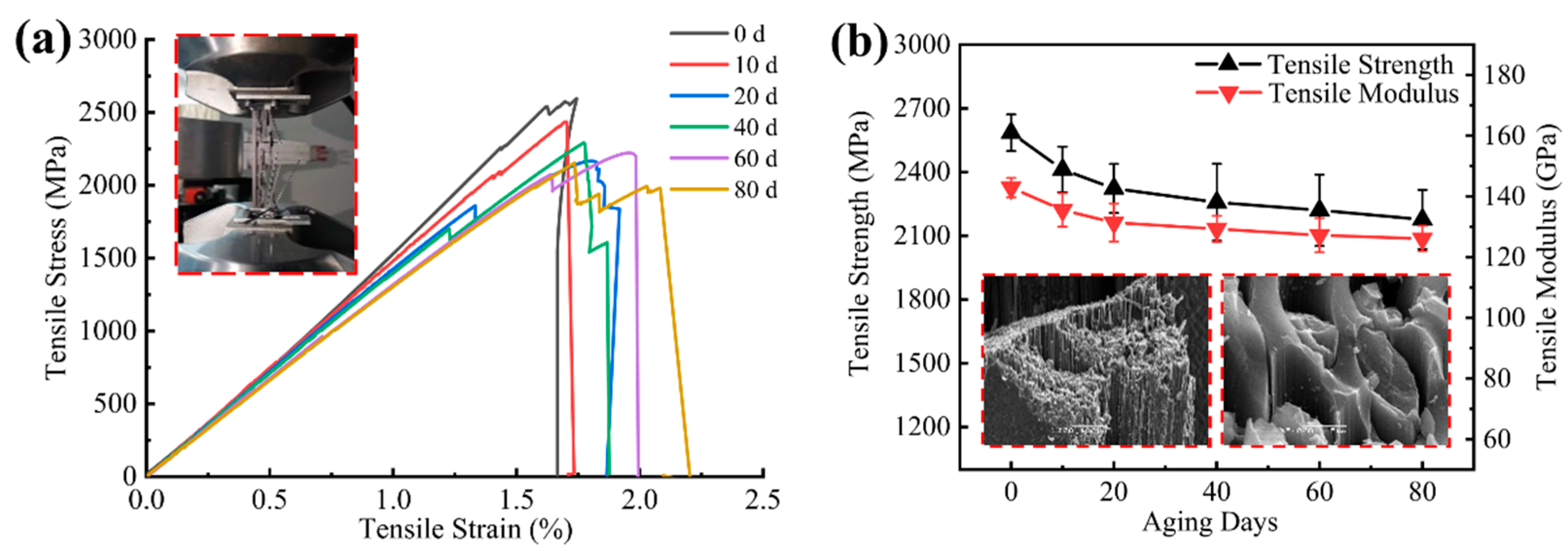
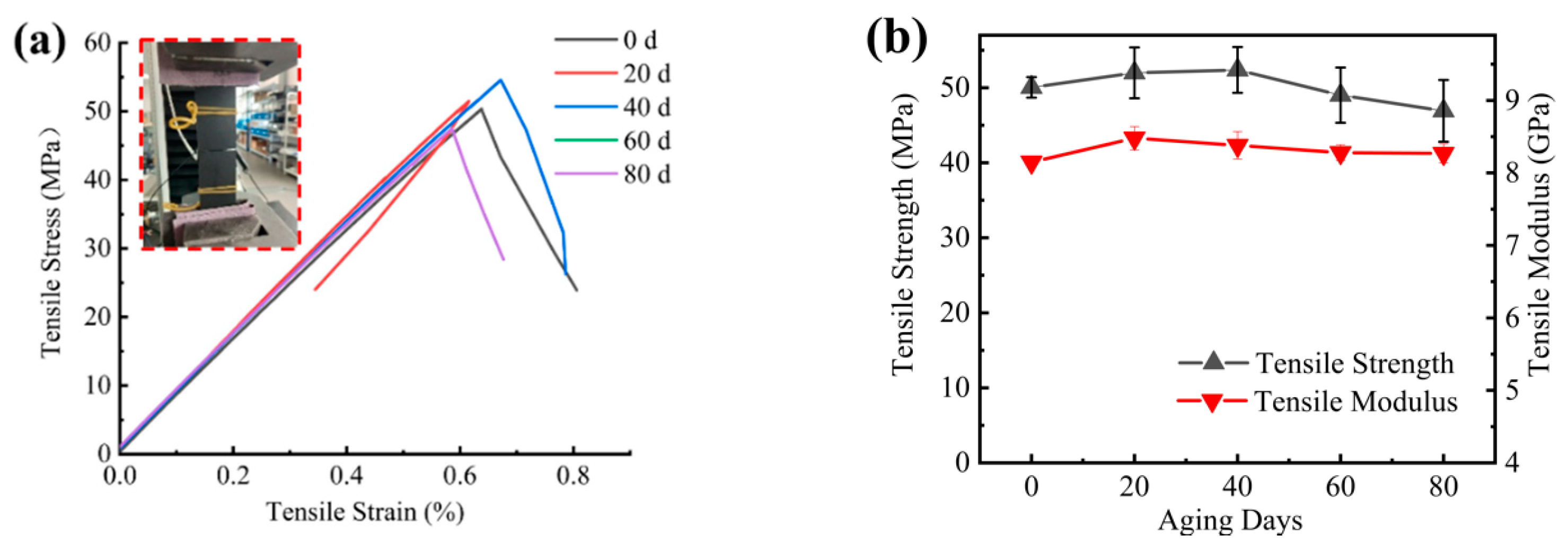
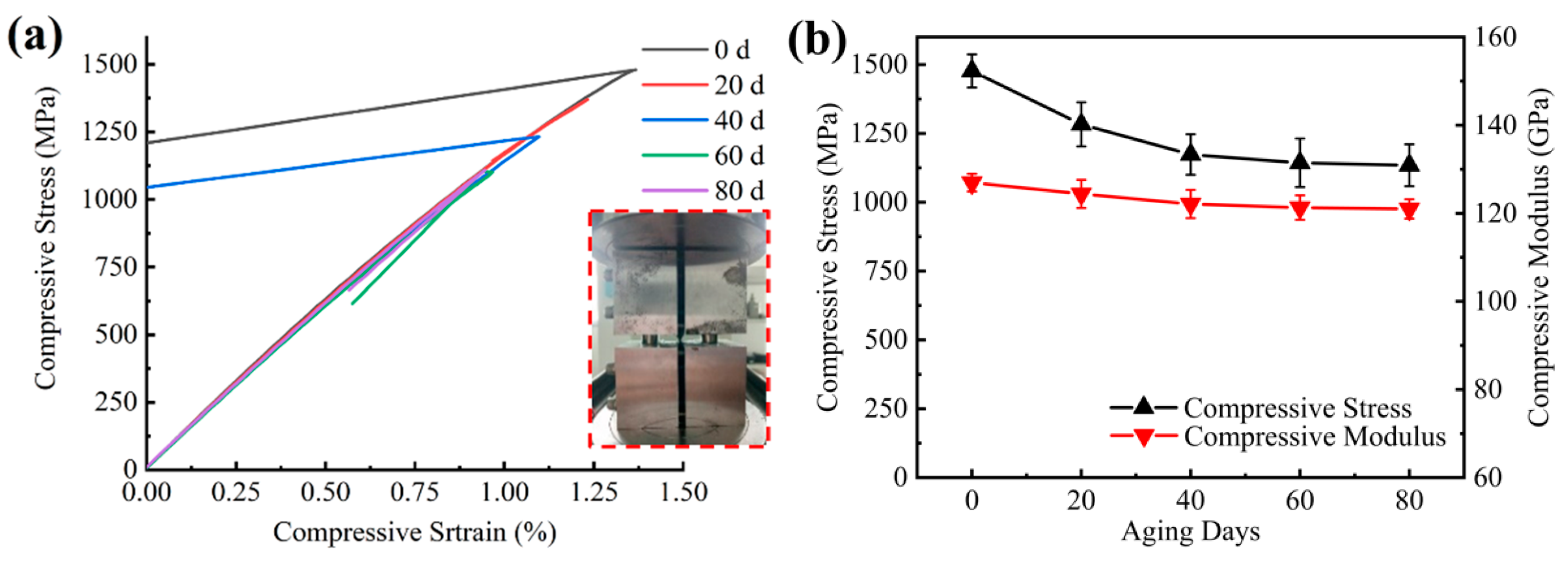
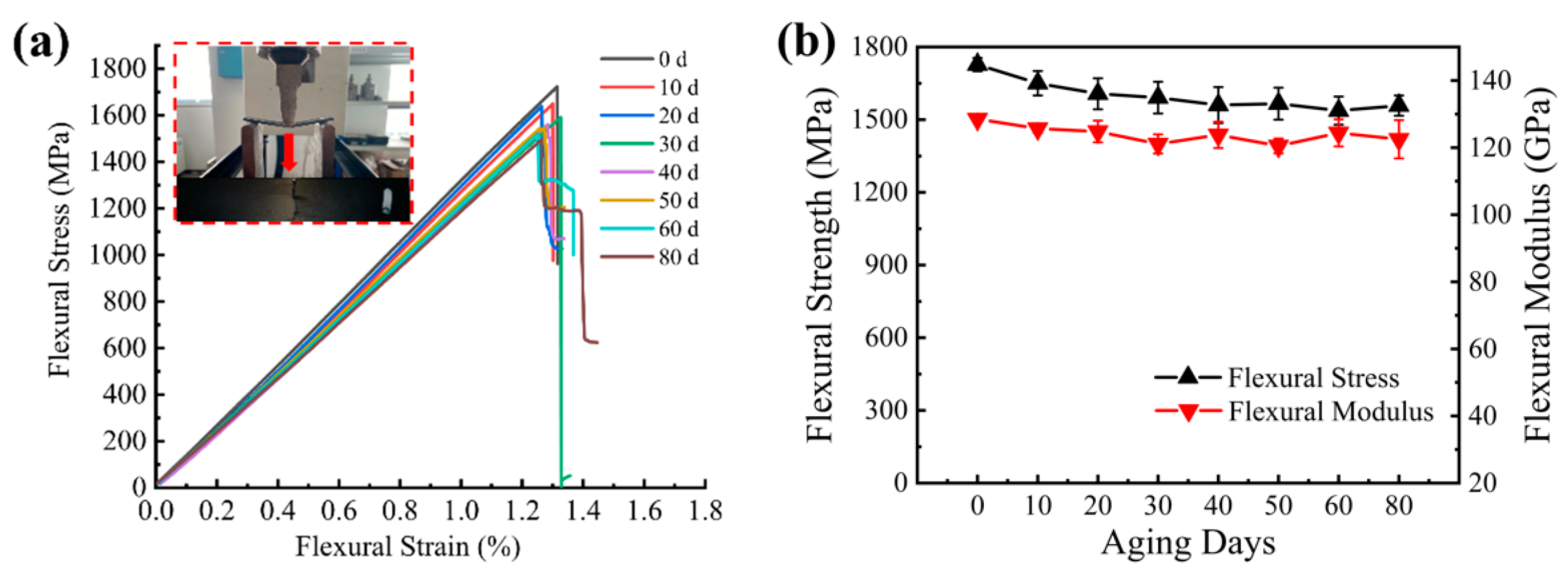
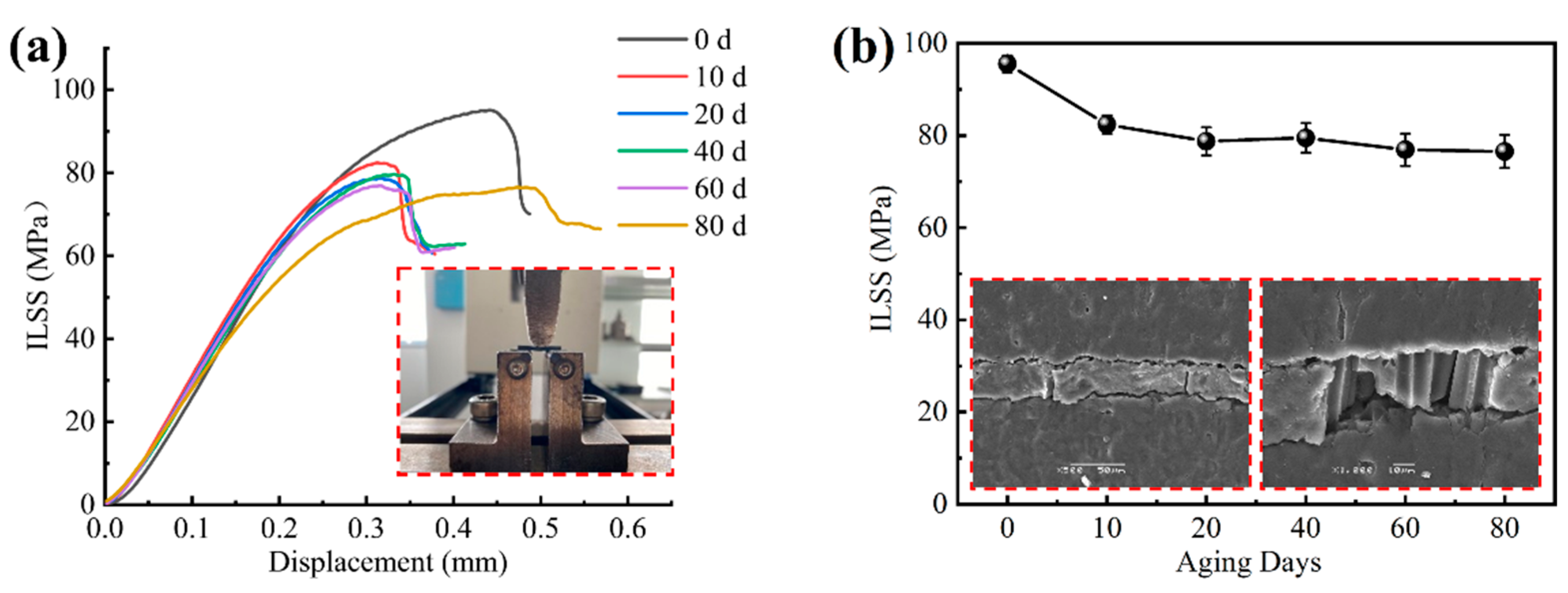
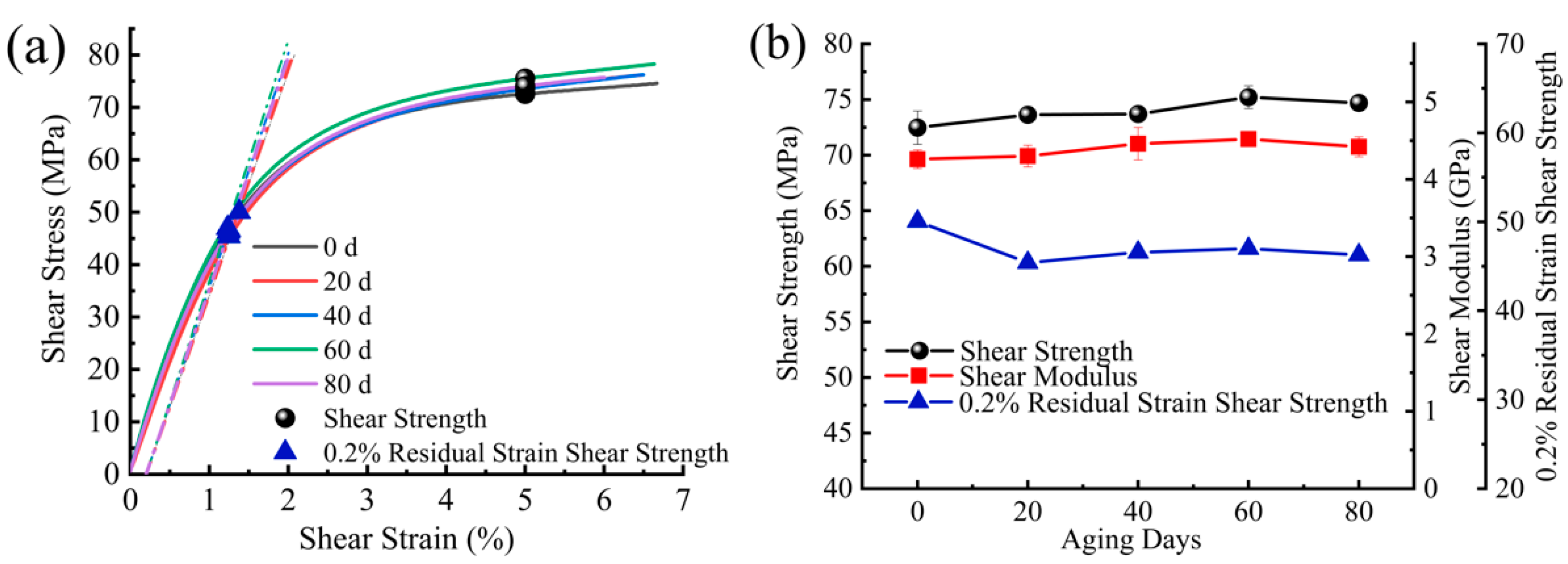


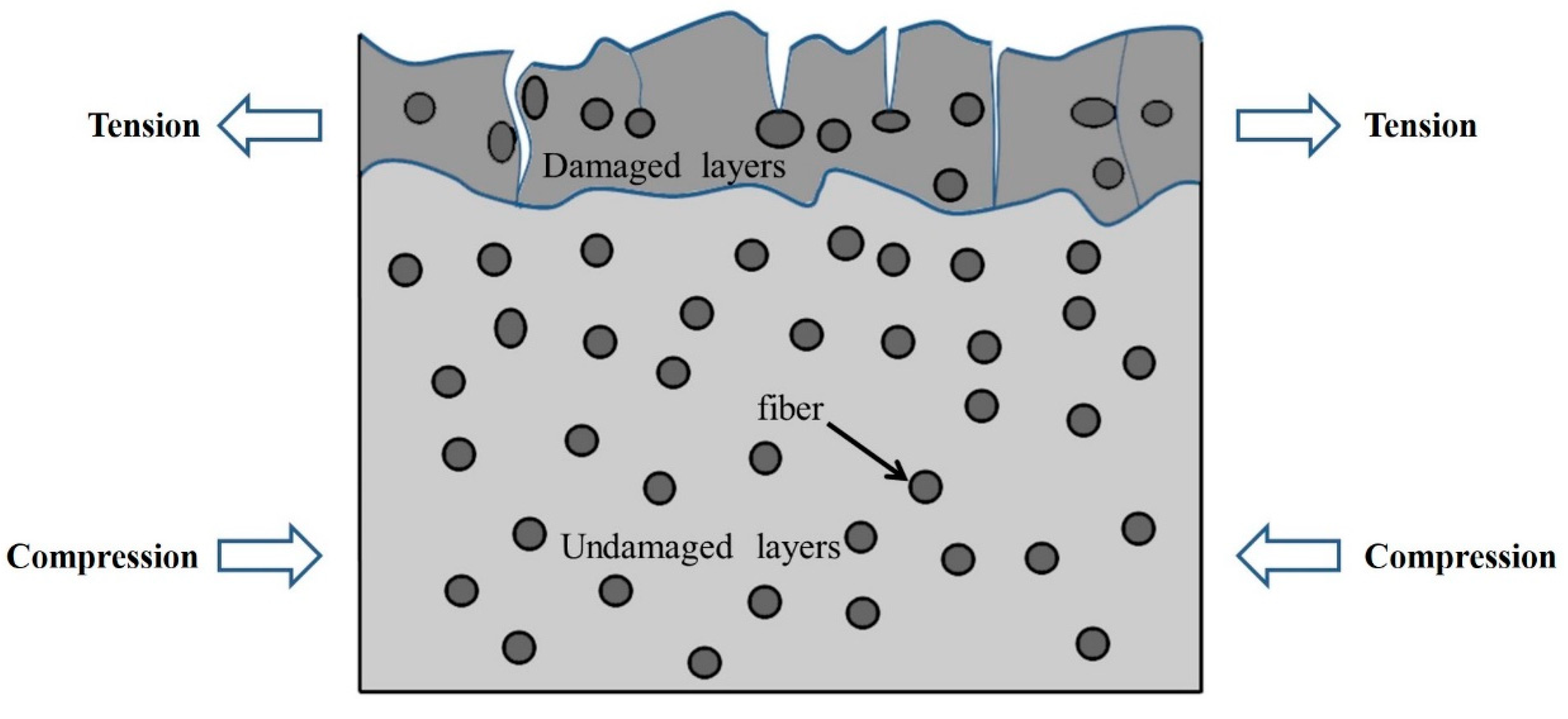
| Fiber Type | Filaments | Tensile Strength (MPa) | Young’s Modulus (GPa) | Elongation (%) | GSM (g/m2) |
|---|---|---|---|---|---|
| T700 | 12 K | 4827 | 234 | 2.1 | 193 |
| Epoxy Resin | Viscosity (Pa.s) | Epoxy Value (eq/100 g) | Volatile Components (%) |
|---|---|---|---|
| Y04 | 10–16 | 0.48–0.54 | ≤2 |
| Test Type | Retention of Strength and Modulus | |||||
|---|---|---|---|---|---|---|
| 10 Days | 20 Days | 40 Days | 60 Days | 80 Days | ||
| Longitudinal Tension | S | 93% | 90% | 87% | 85% | 84% |
| E | 95% | 92% | 90% | 89.% | 88% | |
| Transverse Tension | S | / | 104% | 105% | 98% | 94% |
| E | / | 104% | 103% | 102% | 101% | |
| Longitudinal Compression | S | / | 87% | 79% | 77% | 77% |
| E | / | 98% | 96% | 96% | 95% | |
| Bending | S | 96% | 93% | 90%/ | 89% | 90% |
| E | 98% | 97% | 96% | 97% | 95% | |
| ILSS | S | 86% | 82% | 83% | 80% | 80% |
| V-Notched Shear | S | / | 102% | 102% | 104% | 103% |
| E | / | 101% | 105% | 106% | 104% | |
| Test Type | Fitting Formula | R2 |
|---|---|---|
| Longitudinal Tension | 0.91 | |
| Longitudinal Compression | 0.93 | |
| Bending | 0.95 | |
| ILSS | 0.98 |
Publisher’s Note: MDPI stays neutral with regard to jurisdictional claims in published maps and institutional affiliations. |
© 2022 by the authors. Licensee MDPI, Basel, Switzerland. This article is an open access article distributed under the terms and conditions of the Creative Commons Attribution (CC BY) license (https://creativecommons.org/licenses/by/4.0/).
Share and Cite
Shi, Z.; Zou, C.; Zhou, F.; Zhao, J. Analysis of the Mechanical Properties and Damage Mechanism of Carbon Fiber/Epoxy Composites under UV Aging. Materials 2022, 15, 2919. https://doi.org/10.3390/ma15082919
Shi Z, Zou C, Zhou F, Zhao J. Analysis of the Mechanical Properties and Damage Mechanism of Carbon Fiber/Epoxy Composites under UV Aging. Materials. 2022; 15(8):2919. https://doi.org/10.3390/ma15082919
Chicago/Turabian StyleShi, Zhongmeng, Chao Zou, Feiyu Zhou, and Jianping Zhao. 2022. "Analysis of the Mechanical Properties and Damage Mechanism of Carbon Fiber/Epoxy Composites under UV Aging" Materials 15, no. 8: 2919. https://doi.org/10.3390/ma15082919
APA StyleShi, Z., Zou, C., Zhou, F., & Zhao, J. (2022). Analysis of the Mechanical Properties and Damage Mechanism of Carbon Fiber/Epoxy Composites under UV Aging. Materials, 15(8), 2919. https://doi.org/10.3390/ma15082919





